Prediction Analysis of the Coordinated Development of the Sports and Pension Industries: Taking 11 Provinces and Cities in the Yangtze River Economic Belt of China as an Example
Abstract
1. Introduction
2. Methods and Data
2.1. Index System
2.2. Data Source
3. Research Procedure
3.1. The Calculation Principle of the Entropy Weighting Method
3.2. The Calculation of the Coupling Coordination Degree
3.3. The Quantitative Prediciton Using the GM (1.1) Model
4. Results and Discussions
4.1. Results
4.1.1. Evaluation Value of the Sports and Pension Industries in 11 Provinces of the Yangtze River Economic Belt
4.1.2. The Coupling Coordination Degree of the Sports and Pension Industries in the Yangtze River Economic Belt of China
4.1.3. The Prediction Value of the Development of the Coupling Coordination Degree of the Sports and Pension Industries in the Yangtze River Economic Belt of China
4.2. Discussion
4.2.1. Analysis on the Comprehensive Development Level of the Sports and Pension Industries in the Yangtze River Economic Belt of China
4.2.2. Time and Space Analysis of the Coupling Coordination Degree of the Sports and Pension Industries in the Yangtze River Economic Belt of China
4.2.3. Prediction of the Development of the Coupling Coordination Degree of the Sports and Pension Industries in the Yangtze River Economic Belt of China
4.2.4. Limitations and Future Work
5. Conclusions and Suggestions
5.1. Conclusions
- (1)
- There is an obvious interaction between the sports and pension industries, with remarkable characteristics of coupling and coordinated development. Through the evolution and organization of internal factors, the two industries promote the coordinated development of the sports and pension industries. The coupling and coordinated development of the sports and pension industries not only plays an important role in the pension industry, but also greatly promotes the development of the sports industry itself. Coordinating the coupling relationship between the sports and pension industries is of great significance to the sports and pension industries.
- (2)
- The development level of the sports and pension industries in 11 provinces and cities along the Yangtze River Economic Belt in China is on the rise, and the relationship between the sports and pension industries is relatively high. A higher level of development of the pension industry can promote the sports industry, while the long-term development of the regional sports industry will be restricted by the weak level of the pension industry. Areas with a high level of pension industry are also areas with good development of the sports industry. For example, the development level of two major industries in Jiangsu is the highest in the whole Yangtze River Economic Belt, and the development level of two major industries in Guizhou is in the low value area. The fluctuation range of the whole regional pension industry level is relatively small, while the fluctuation of the sports industry development level is relatively strong. The sports industry has become an effective path to reduce the regional development differences. The development of the pension industry in the Yangtze River Economic Belt plays a greater role in promoting the sports industry, while the development of the sports industry plays a weaker role in promoting the pension industry.
- (3)
- The coupling coordination of the sports and pension industries in 11 provinces of the Yangtze River Economic Belt is steadily increasing year by year, but the pace of evolution and promotion is relatively slow, and the coordination relationship is between the reluctant coordination and primary coordination levels. However, the prediction results show that the evolution and upgrading speed of the coupling coordination level will significantly accelerate in 2018–2022, and the two major industries in the whole region will continue to develop in a more comprehensive, coordinated and orderly direction. The evolution and upgrading speed of the coupling coordination level is faster. In addition, there is a large spatial difference in the coupling coordination between the sports and pension industries in 11 provinces of the Yangtze River Economic Belt. The spatial pattern from the lower reaches of the Yangtze River to the upper reaches of the Yangtze River generally presents a pattern of “medium-high-medium-low-high-low-high-high-high-high”, and there is still a significant spatial difference in the predicted next five years.
5.2. Suggestions
- (i)
- As a province with significant driving role of the sports industry, Jiangsu should make full use of the regional advantages of sports competition platforms and the Yangtze River Delta, pay attention to the innovation strategy of the sports industry, start with the development and operation mechanism and management system of the sports industry, promote the development of the sports industry and the liberation of productivity, and further reform and innovation of the sports industry System, so as to form a new experience and model of the sports industry driving the pension industry and create a new type of “sports + pension” industry.
- (ii)
- Zhejiang, Shanghai and Yunnan, as provinces and cities with a more prominent driving role of the sports industry, should use the integration strategy of the sports industry to promote the transformation of the development mode of the sports industry from a quantitative model to a quality and efficiency model through the integration of the sports industry and the culture, pension, education, health, agriculture, forestry, water conservancy, general aviation, transportation and other industries. Considering that the education industry has been upgraded, these provinces and cities can develop as characteristic towns of the sports industry, promote the development of the “sports + pension” industry and realize the unity of sports industry benefits and pension industry benefits.
- (iii)
- Anhui, Jiangxi, Hubei, Hunan, Chongqing, Sichuan and Guizhou, as provinces and cities with no obvious driving role of the sports industry, should cultivate the sports industry as an important engine of the pension industry and continue to optimize the environment for the development of the sports industry. They should give full play to the advantages of the regional ecological environment, develop ecological sports and low-carbon sports, accelerate the release of the potential value of sports, and constantly enlarge the comparative advantages of sports. Thus, the sports industry could become an important force in the development of the pension industry. In addition, they should provide a service guarantee and necessary facilities for the development of the sports industry, and further promote the development of the “sports + pension” industry.
- (i)
- The Yangtze River Economic Belt should enhance the spatial spillover effect of the growth pole of the Jiangsu sports industry in the Yangtze River Delta. With the help of the high-speed railway along the Yangtze River and the golden waterway and other axes, through government cooperation, the flow of production factors and industrial transfer and other forms, the development of the sports and pension industries in the Yangtze River Economic Belt will be driven, radiated and led. Through the development of central cities such as Wuhan and Chengdu in Hubei, and Sichuan and other provinces in the central and western regions of the Yangtze River Economic Belt, the development of other urban agglomerations will be driven, leading the regional development of the “sports + pension” industry and specialized production. In this way, it can promote the reasonable flow of regional elements and resources, so as to achieve the improvement of the overall development level of the sports and pension industries in the Yangtze River Economic Belt and the reduction of the development differences between provinces and cities.
- (ii)
- The Yangtze River Economic Belt should establish an all-round cooperation mechanism and industrial linkage mechanism based on sports industry cooperation and driven by the sports industry, and comprehensively deepen the cooperation of relevant departments, so as to lead the construction of regional integration. On the one hand, a Joint Working Committee of the sports industry of 11 provinces and cities in the Yangtze River Economic Belt should be established, and a multi-level consultation system should be established. Under the joint working committee, sports industry cooperation organizations of different management levels and administrative levels should be established to jointly promote the integrated development of the sports industry in the Yangtze River Economic Belt. On the other hand, they should expand the field of sports cooperation, guide the main body of the sports market to break the restrictions of the original administrative divisions, and expand the content of cooperation from sports brands and sports products to intelligent sports and sports management. The above measures can realize the coordinated development of the sports industry, the sports market and sports resources in the Yangtze River Economic Belt, and form a coordinated development mode of “the sports industry provides sports fitness elements for the pension industry, and the pension industry provides a pension service market for the sports industry”.
Author Contributions
Funding
Conflicts of Interest
References
- Hua, Y. Building a Healthy China: Strategic Significance, Challenge, Key measures. J. Chin. Acad. Gov. 2017, 20, 105–111. [Google Scholar]
- Ren, H. Sport industries’ impacts on sport development in China. China Sport Sci. 2015, 35, 13–18. [Google Scholar]
- Han, N.C. Basic research on the development demand and consumption pattern of Beijing community residents’ life service industry. Econ. Trade Update 2016, 25, 28–43. [Google Scholar]
- Xie, Y.N. Research on big data boosting the development of pension industry. China Bus. Trad. 2017, 15, 146–147. [Google Scholar]
- Rosenberg, N. Technological change in the machine tool industry. J. Econ. Hist. 1963, 23, 414–446. [Google Scholar] [CrossRef]
- Zhuang, M. On the interactive development of cultural industry and tourism industry from the perspective of “industrial integration. GongGeng 2011, 1, 58–59. [Google Scholar]
- Li, M.Y. New development of foreign industry integration research. Foreign Econ. Manag. 2005, 27, 12–20. [Google Scholar]
- Ono, R.; Aoki, K. Convergence and new regulatory frameworks: A comparative study of regulatory approaches to Internet telephony. Telecommun. Policy 1988, 22, 817–838. [Google Scholar] [CrossRef]
- Li, C.; Li, W.; Zhang, L.Q. Review and Prospect of life cycle theory of emerging industries abroad. Sci. Tech. Prog. Policy 2015, 2, 156–160. [Google Scholar]
- Li, J.H.; Guo, Y.H. The evolution of foreign industrial life cycle theory. J. Humanit. 2001, 6, 62–65. [Google Scholar]
- Yu, R.G. Three classifications and industry convergence trends. Rev. Econ. Res. 1997, 19, 46–47. [Google Scholar]
- Ma, J. Review of research on industrial integration theory. Econ. Infor. 2002, 43, 78–81. [Google Scholar]
- Li, W.Y.; Wang, Z. Frontier Issues of China’s Industrial Development; Shanghai People’s Publishing House: Shanghai, China, 2003; pp. 175–189. [Google Scholar]
- Zhou, Y. Research on Enterprise Innovation Investment Decision for Industry Convergence. Master’s Thesis, Fudan University, Shanghai, China, 2012. [Google Scholar]
- Shan, Y.Y.; Zhao, Y.L. Foreign theoretical research progress on industry convergence. Econ. Rev. 2012, 33, 152–158. [Google Scholar]
- Ma, J. Review of industrial integration theory. Econ. Infor. 2002, 5, 80–83. [Google Scholar]
- Cheng, L.L. Analysis on industry amalgamation of sport. J. Chengdu Phys. Educ. Inst. 2005, 31, 22–25. [Google Scholar]
- Zha, S.X.; Zhang, L.M.; Liu, D.S. Research on the integrated development of Chinese sports industry and health service industry. Sports Cult. Guide 2016, 34, 106–109. [Google Scholar]
- Ye, S.Z. Interactive mechanism and integration process of the sports industry and the pension industry. J. Xi’an Phys. Educ. Univer. 2017, 34, 442–446. [Google Scholar]
- Shen, K.Y.; Dong, Q.Q. Local characteristics and development strategy of sports resort town-Taking Keqiao Kuwan Town in Zhejiang province for example. J. Wuhan Inst. Phys. Educ. 2018, 52, 25–31. [Google Scholar]
- Tian, Q. The background and effect analysis of the integral development between sports industry and tourism. J. Xi’an Inst. Phys. Educ. 2014, 31, 168–170. [Google Scholar]
- He, D.M.; Wang, Z.W. A study on the time and space evolution of the coupling coordination degree of the pension industry and regional economy: A case study of Jiangsu Province. Modern Manag. 2019, 3, 16–22. [Google Scholar]
- Zhu, Y.T.; Zhao, Y. Construction of evaluation index system of ecological security of land resource in Sichuan Province. J. Anhui Agri. Sci. 2016, 44, 195–198. [Google Scholar]
- Zhang, H. Stylized facts of openness in China’s regional trade agreement in service: Based on Hoekman frequency ratio. Inter. Econ. Trade Res. 2017, 33, 19–32. [Google Scholar]
- Wang, Q.W.; Wang, M.; Zhu, H. Research on the construction and driving mechanism of brand cognition niche of sports products. J. Sports Sci. 2018, 39, 73–85. [Google Scholar]
- Lv, Z.F.; Shi, P. The construction of evaluation system of football offensive ability based on subjective and objective comprehensive weighting method and fuzzy comprehensive evaluation. China School Phys. Educ. 2018, 5, 53–58. [Google Scholar]
- Abdi, H.; Williams, L.J. Principal component analysis. Wiley Interdiscip. Rev. Comput. Stat. 2010, 2, 433–459. [Google Scholar] [CrossRef]
- Feng, X.G.; Li, Y. Construction of indicators weights and evaluation system of physical education teachers based on AFS and PCA. J. Langfang Teach. Univ. 2014, 14, 67–70. [Google Scholar]
- Yang, Z.W.; Wu, Y.; Yuan, D.M. A quantitative study of Delphi method. Inform. Stud. Theroy Appl. 1995, 5, 11–13. [Google Scholar]
- Yu, H.G. The introduction of a new method to determine the weight of evaluation index. Chin. J. Med. Sci. Res. Manag. 1996, 2, 88–89. [Google Scholar]
- Zhang, Y.; Deng, X.H.; Gao, X.; Dou, Y.J.; Peng, B.Z. Evaluation of environmental comprehensive quality by improved analytical hierarchy process method. Res. Environ. Yangtze Basin 2006, 15, 120–124. [Google Scholar]
- Wang, F.X.; Mao, A.H.; Li, H.L.; Jia, M.L. Quality measurement and regional difference of urbanization in Shandong province based on the entropy method. Sci. Geog. Sin. 2013, 33, 1323–1329. [Google Scholar]
- Qu, A.X. A study on the synthetical measure of the new industrialization level in Jiangsu Province. Econ. Geog. 2006, 26, 55–59. [Google Scholar]
- Huang, S. A Study on the Coupling Relationship between Tourism Industry Agglomeration and Regional Economy-Taking Xiamen, Quanzhou and Zhangzhou as Examples. Master’s Thesis, Huaqiao University, Quanzhou, China, 2012; pp. 21–24. [Google Scholar]
- Xie, B.G.; Chen, Y.L.; Li, X.Q. The application of coupling coordination model in the evaluation of “Beautiful China” construction. Econ. Geog. 2016, 36, 38–44. [Google Scholar]
- Chai, J.; Wang, Z.; Zhang, H. Integrated evaluation of coupling coordination for land use change and ecological security: A case study in Wuhan City of Hubei Province, China. Inter. J. Environ. Res. Pub. Health 2017, 14, 1435. [Google Scholar] [CrossRef] [PubMed]
- Shi, P.F.; Li, X.M.; Xiong, Y.B. Coupling measurement and prospect forecast of regional “Beautiful China” construction and tourism industry development—A case study of 11 provinces along the Yangtze River Economic Belt. China Soft Sci. 2018, 33, 86–102. [Google Scholar]
- Ou, X.J.; Zhen, F.; Qin, Y.D. Study on compression level and ideal impetus of regional urbanization: The case of Jiangsu province. Geog. Res. 2008, 27, 993–1002. [Google Scholar]
- Zhang, G.H.; Liu, Z.Z.; Wang, X.Y. Analysis and forecast of coupling degree between tourism-oriented development and eco-enviroment in coastal region of China. Eco. Environ. Sci. 2013, 22, 792–800. [Google Scholar]
- Yang, W.; Yang, M. Study on coupling coordination degree model of scientific and technological innovation and economic development in China. Forum Sci. Tech. China 2016, 3, 30–35. [Google Scholar]
- Weng, G.M.; Li, L.Y. The coupling coordination degree and spatial correlation analysis on integrational development of tourism industry and cultural industry in China. Econ. Geog. 2016, 36, 178–185. [Google Scholar]
- Hou, B.; Zhou, X.Q. Assessment and evaluation of integration of the culture industry and tourism industry in Yangtze River Delta. Econ. Geog. 2015, 35, 211–217. [Google Scholar]
- Nguyenn, N.T.; Nguyen, B.P.U.; Tran, T.T. Application of grey system theory and ARIMA model to forecast factors of tourism: A case of Binh Thuan Province in Vietnam. Inter. J. Adv. Appl. Sci. 2020, 7, 87–99. [Google Scholar]
- He, H. Analysis and Forecast of Coupling Coordination Development among the Tourism Industry—Regional Economy-Ecological Environment in Hanzhong. J. Anhui Agric. 2017, 45, 165–170. [Google Scholar]
- Huang, Y.L. Forecasting the demand for health tourism in Asian countries using a GM (1, 1)-Alpha model. Tour. Hosp. Manag. 2012, 18, 171–181. [Google Scholar]
- He, X.H.; Bai, K.; Wei, H.Y. Evaluation index system of inbound tourism cities’ image based on WE-GCM: A case study in Beijing and Shanghai. Tour. Forum 2011, 4, 68–70. [Google Scholar]
- Zhao, Y.L.; Dai, T.H. Analysis on the regional characteristics during development of the sports industry in China—Based on the existing provincial data. Chin. Spo. Sci. Tech. 2019, 55, 31–42. [Google Scholar]
- He, Q.J.; Yang, X.W. Analysis of coupling and coordination degree between comprehensive health industry and old-age service. Soft Sci. 2019, 33, 45–49. [Google Scholar]
- Wang, W.; Ma, J.; Li, H.Y. Analysis and evaluation of regional development environment of China’s pension industry. J. Commer. Econ. 2018, 7, 185–189. [Google Scholar]
- Han, S.; Wang, L. Assessment and evaluation of converging trend of the sports and pension industries in China. Chin. Spo. Sci. 2017, 37, 3–10. [Google Scholar]
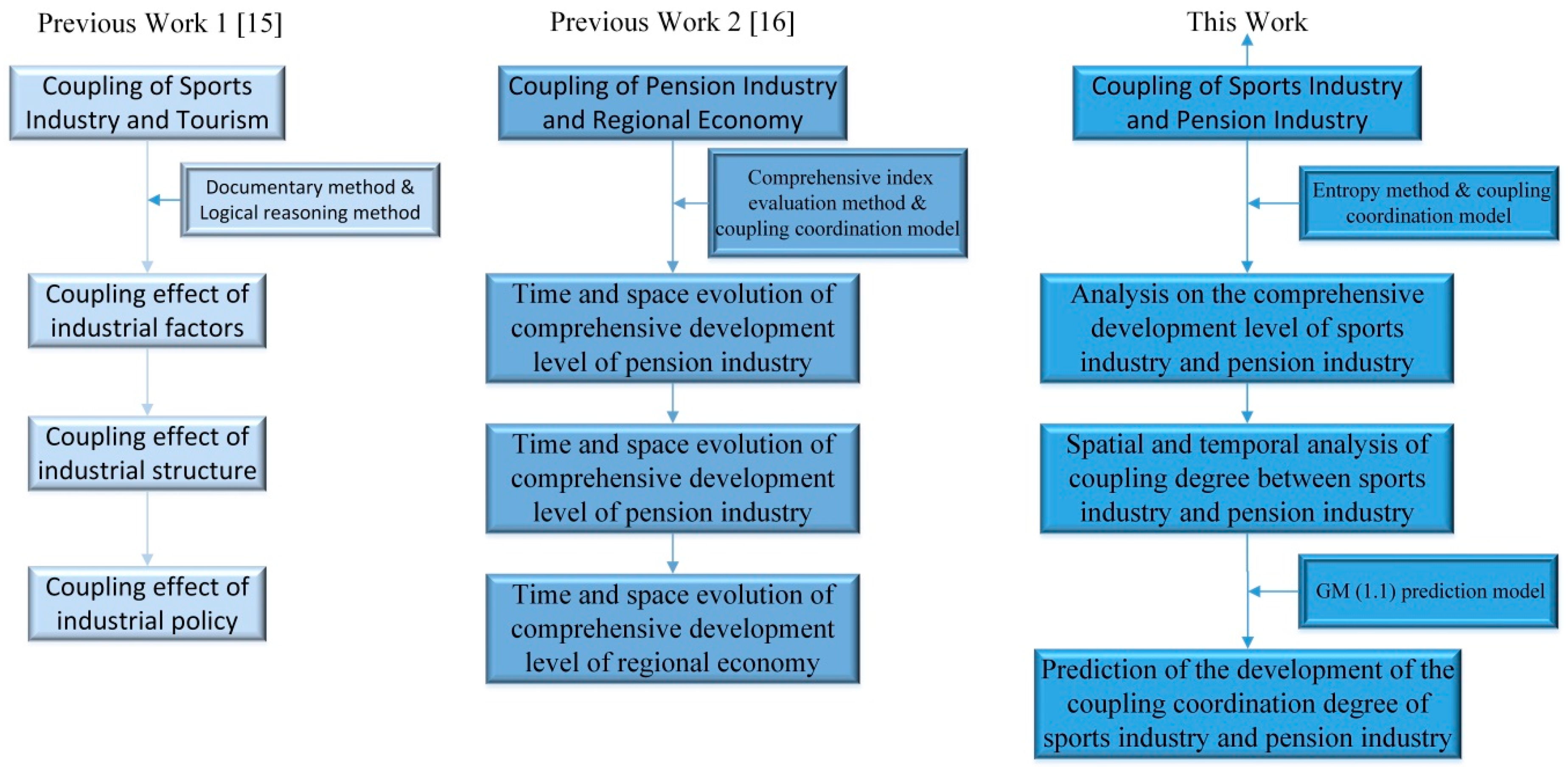
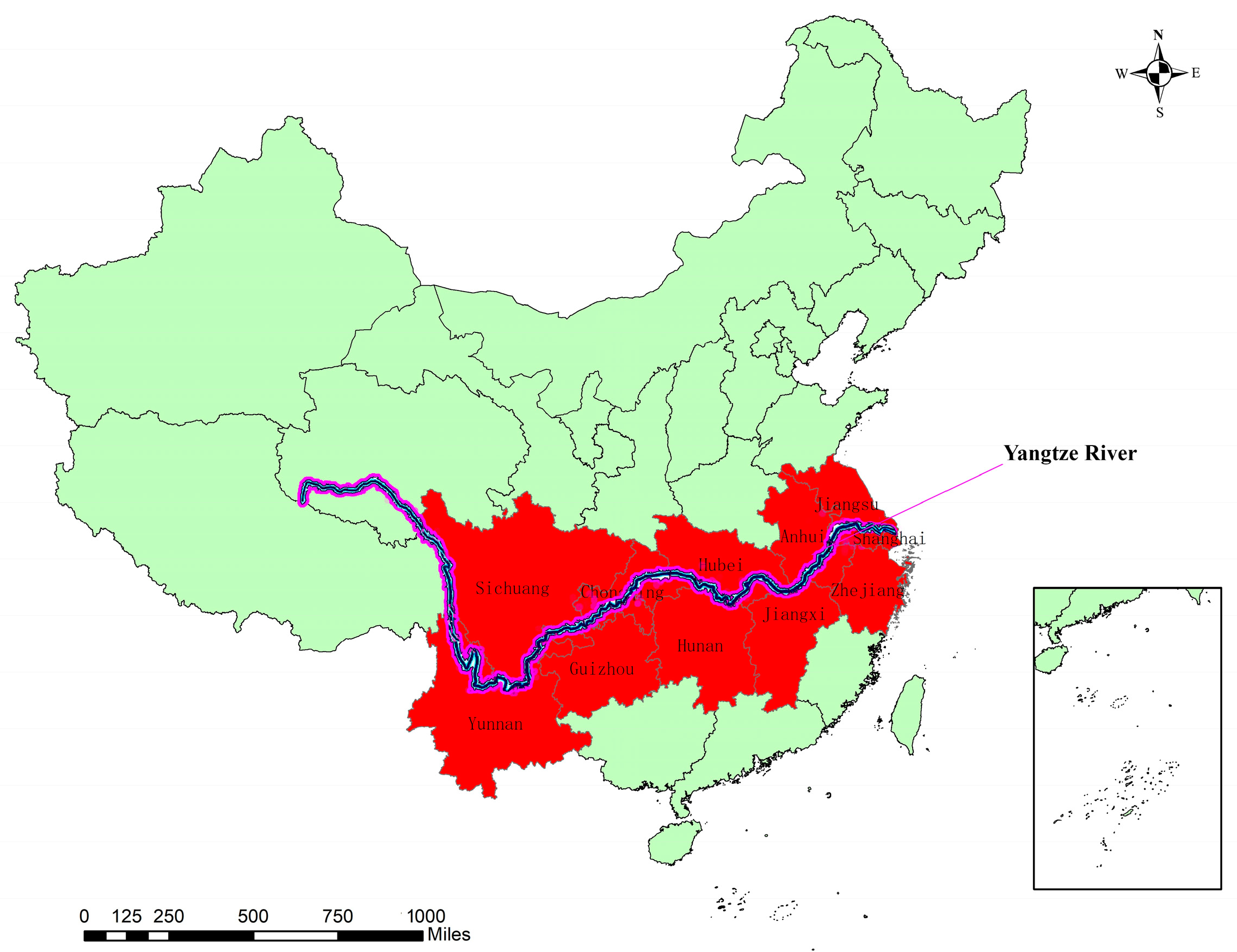
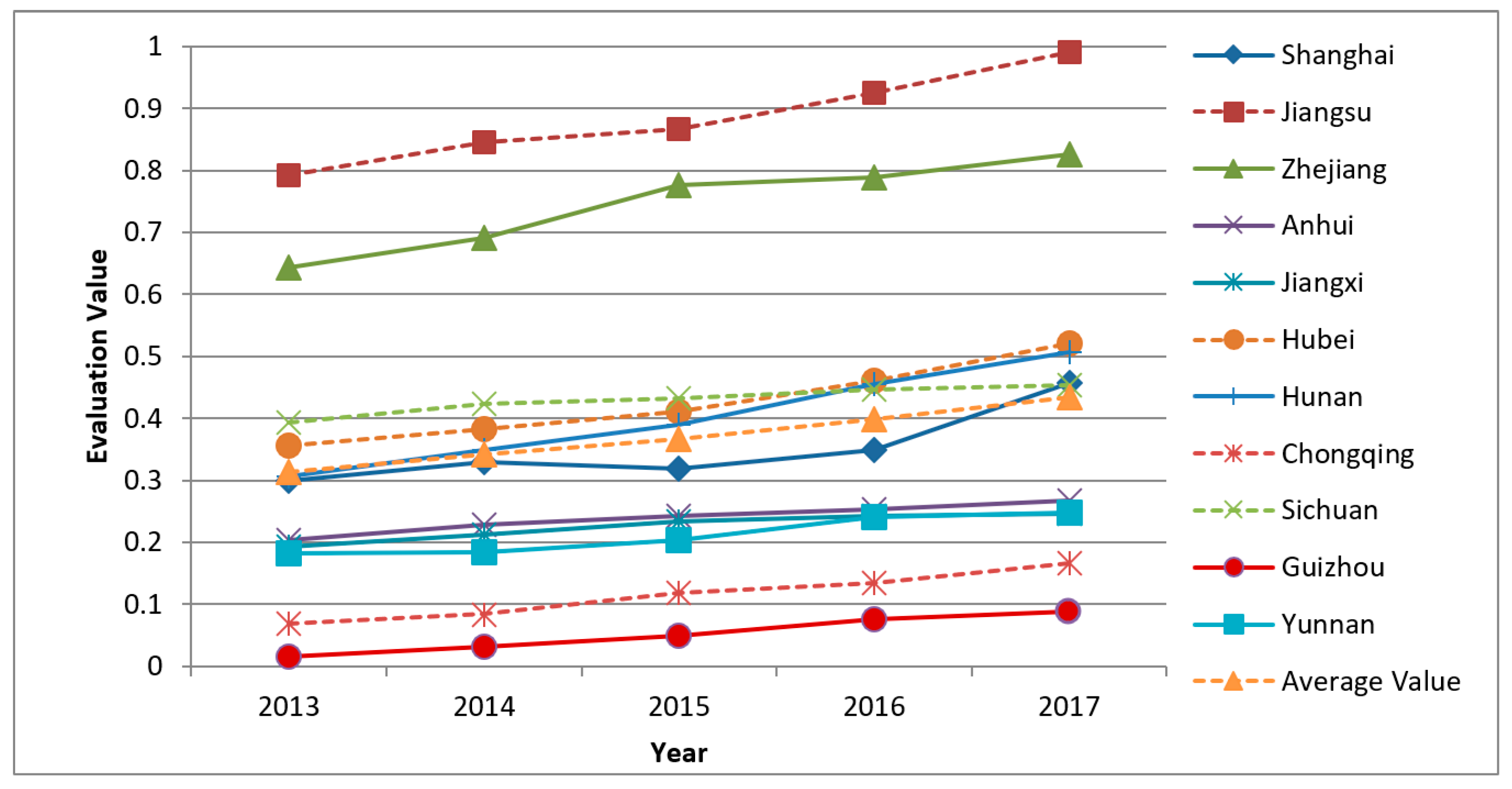
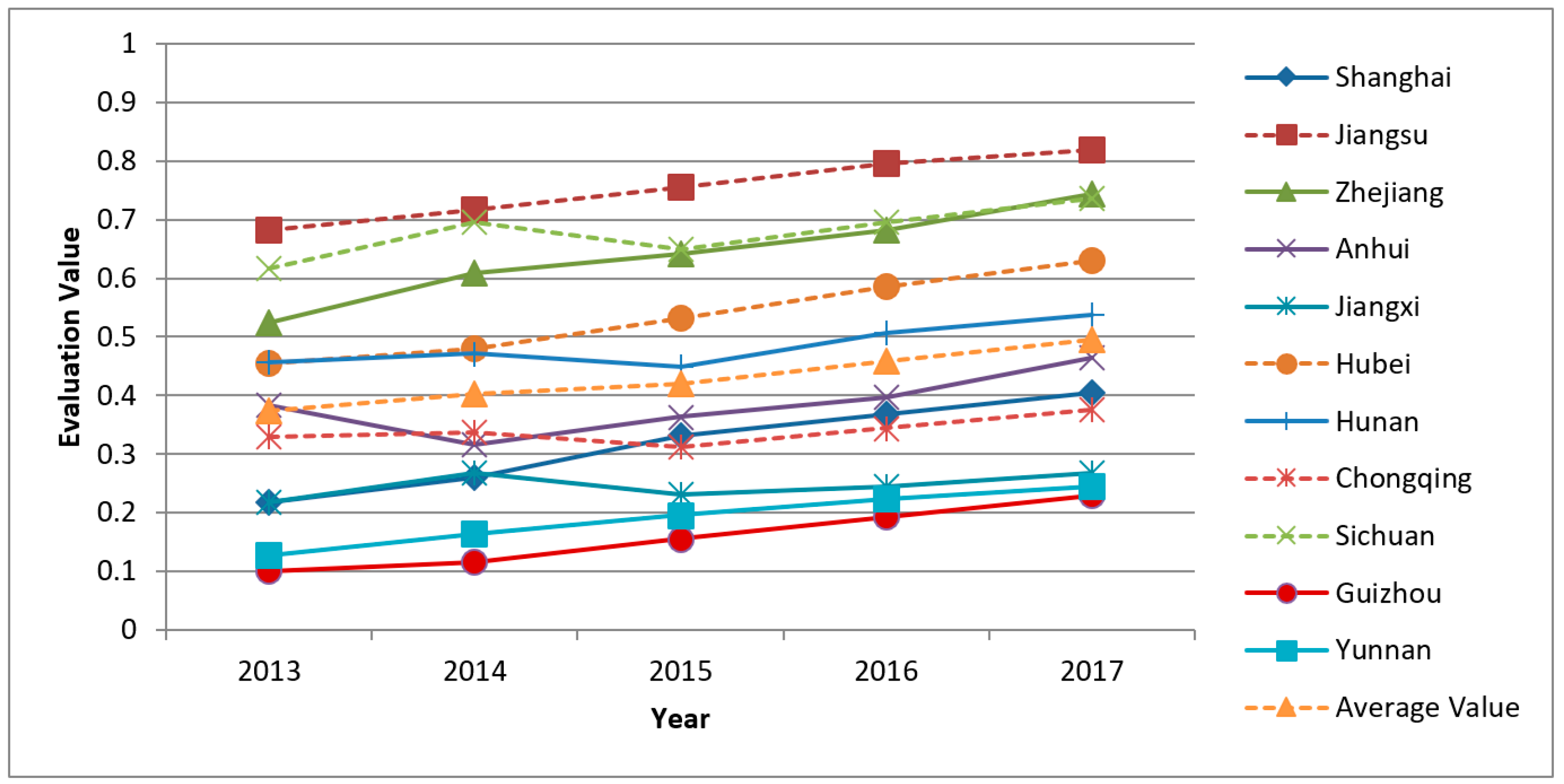
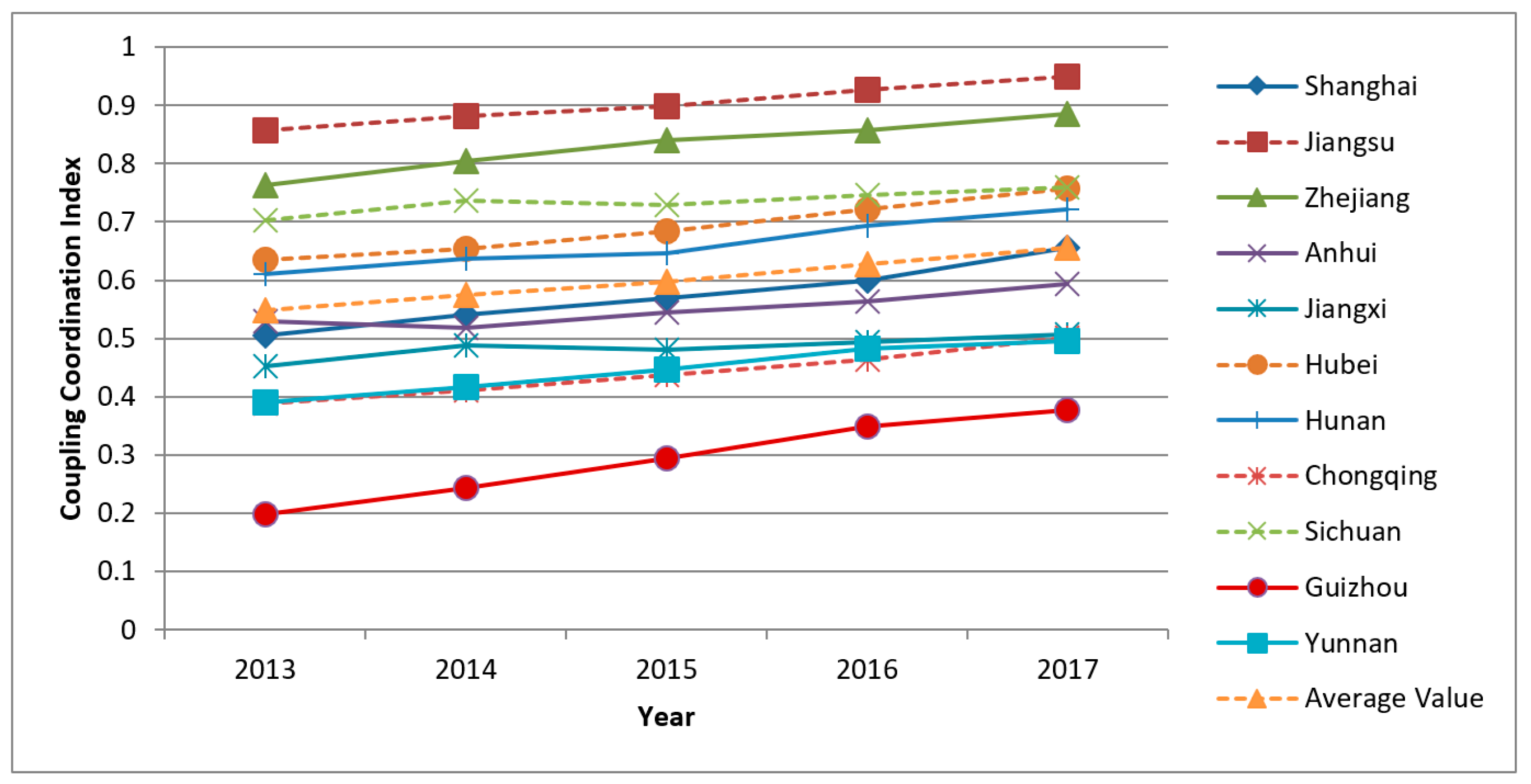
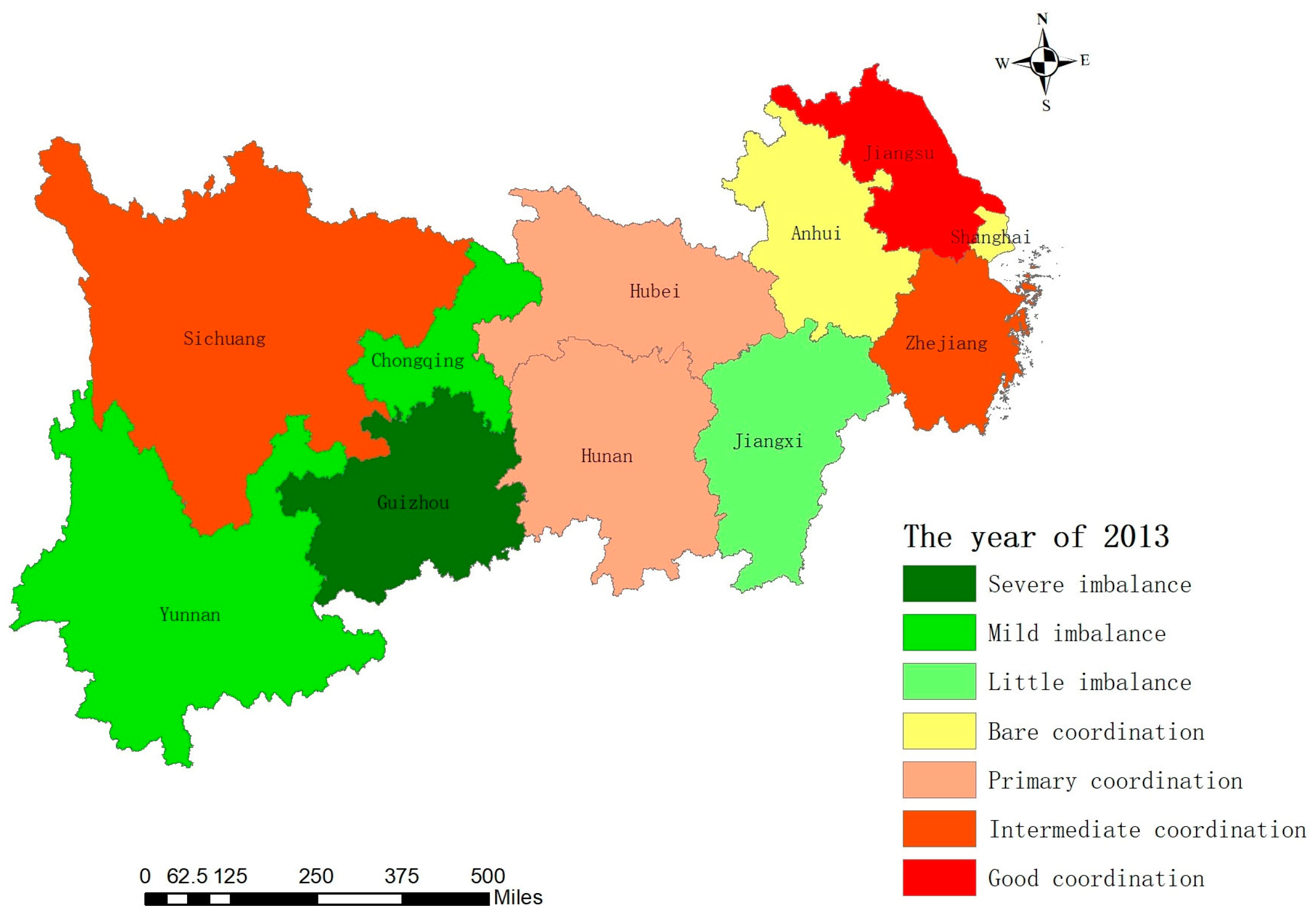
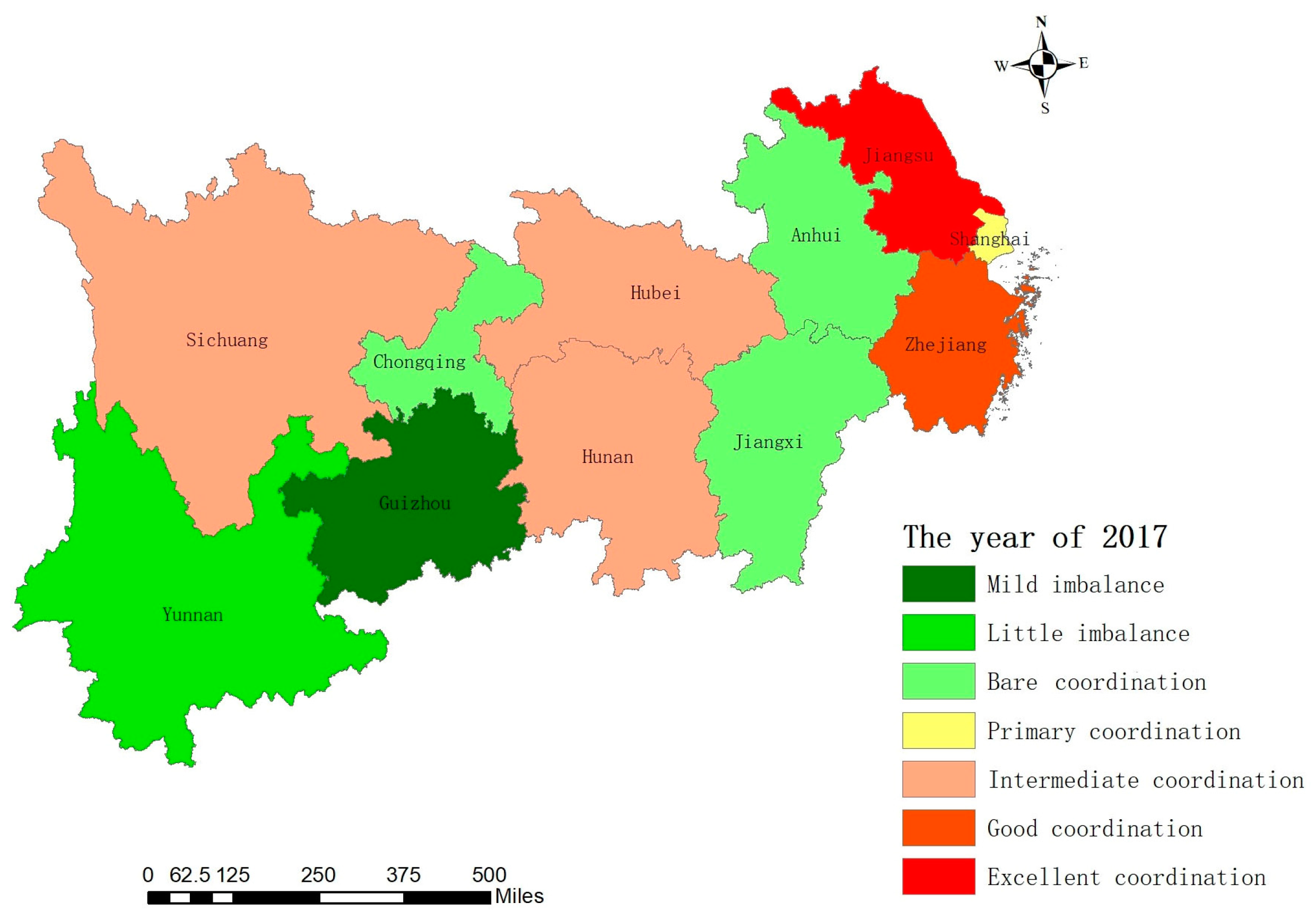
| Coupling System | First Level Index | Second Level Index | Entropy | Difference Coefficient | Weight |
|---|---|---|---|---|---|
| Sports Industry System | Economic contribution | Added value of the sports industry (100 million yuan) | 0.995578 | 0.004422 | 0.158941 |
| Sports expenses (100 million yuan) | 0.995055 | 0.004945 | 0.177757 | ||
| Sales of sports lottery (10,000 yuan) | 0.995843 | 0.004157 | 0.149415 | ||
| Foundation scale | Number of sports system institutions | 0.997136 | 0.002864 | 0.102963 | |
| Number of sports venues | 0.993695 | 0.006305 | 0.226653 | ||
| Employees (10,000 persons) | 0.994874 | 0.005126 | 0.18427 | ||
| Pension Industry System | Economic contribution | Unit income of pension service industry (100 million yuan) | 0.995302 | 0.004698 | 0.184252 |
| Unit assets of pension service industry (100 million yuan) | 0.997065 | 0.002935 | 0.115118 | ||
| Sales of welfare lottery (100 million yuan) | 0.995293 | 0.004707 | 0.184616 | ||
| Foundation scale | Number of pension service institutions | 0.995404 | 0.004596 | 0.180276 | |
| Number of beds for the aged | 0.997518 | 0.002482 | 0.097345 | ||
| Employees (10,000 persons) | 0.993922 | 0.006078 | 0.238393 |
| Serial Number | Range of D Value | Coupling Coordination Degree Level |
|---|---|---|
| 1 | 0.00–0.09 | Extreme imbalance |
| 2 | 0.10–0.19 | Severe imbalance |
| 3 | 0.20–0.29 | Moderate imbalance |
| 4 | 0.30–0.39 | Mild imbalance |
| 5 | 0.40–0.49 | Little imbalance |
| 6 | 0.50–0.59 | Bare coordination |
| 7 | 0.60–0.69 | Primary coordination |
| 8 | 0.70–0.79 | Intermediate coordination |
| 9 | 0.80–0.89 | Good coordination |
| 10 | 0.90–1.00 | Excellent coordination |
| Accuracy Grade | Small Error Probability (P) | Mean Square Deviation Ratio (C) |
|---|---|---|
| Good | >0.95 | <0.35 |
| Qualified | >0.80 | <0.50 |
| Barely qualified | >0.70 | <0.65 |
| Unqualified | ≥0.70 | ≤0.65 |
| Year | |||||
|---|---|---|---|---|---|
| 2018 | 2019 | 2020 | 2021 | 2022 | |
| Shanghai | 0.691882 | 0.737715 | 0.786583 | 0.838689 | 0.894246 |
| Jiangsu | 0.973239 | 0.99798 | 1.023351 | 1.049366 | 1.076042 |
| Zhejiang | 0.913162 | 0.941379 | 0.970468 | 1.000456 | 1.031371 |
| Anhui | 0.619365 | 0.647507 | 0.676928 | 0.707686 | 0.739841 |
| Jiangxi | 0.509469 | 0.516396 | 0.523418 | 0.530536 | 0.53775 |
| Hubei | 0.79457 | 0.834589 | 0.876623 | 0.920775 | 0.967151 |
| Hunan | 0.754088 | 0.788909 | 0.825339 | 0.863451 | 0.903322 |
| Chongqin | 0.532521 | 0.568787 | 0.607523 | 0.648897 | 0.693088 |
| Sichuan | 0.765563 | 0.774904 | 0.784358 | 0.793928 | 0.803615 |
| Guizhou | 0.442367 | 0.509028 | 0.585736 | 0.674003 | 0.775571 |
| Yunnan | 0.532122 | 0.564603 | 0.599067 | 0.635635 | 0.674435 |
| Average value | 0.684395 | 0.716527 | 0.750854 | 0.787584 | 0.826948 |
| Area | Suggestion |
|---|---|
| Jiangsu Province |
|
| Shanghai City, Zhejiang and Yunnan Provinces |
|
| Chongqing City, Anhui, Jiangxi, Hubei, Hunan, Sichuan and Guizhou Provinces |
|
© 2020 by the authors. Licensee MDPI, Basel, Switzerland. This article is an open access article distributed under the terms and conditions of the Creative Commons Attribution (CC BY) license (http://creativecommons.org/licenses/by/4.0/).
Share and Cite
Zhuo, L.; Guan, X.; Ye, S. Prediction Analysis of the Coordinated Development of the Sports and Pension Industries: Taking 11 Provinces and Cities in the Yangtze River Economic Belt of China as an Example. Sustainability 2020, 12, 2493. https://doi.org/10.3390/su12062493
Zhuo L, Guan X, Ye S. Prediction Analysis of the Coordinated Development of the Sports and Pension Industries: Taking 11 Provinces and Cities in the Yangtze River Economic Belt of China as an Example. Sustainability. 2020; 12(6):2493. https://doi.org/10.3390/su12062493
Chicago/Turabian StyleZhuo, Lin, Xiangfeng Guan, and Songzhong Ye. 2020. "Prediction Analysis of the Coordinated Development of the Sports and Pension Industries: Taking 11 Provinces and Cities in the Yangtze River Economic Belt of China as an Example" Sustainability 12, no. 6: 2493. https://doi.org/10.3390/su12062493
APA StyleZhuo, L., Guan, X., & Ye, S. (2020). Prediction Analysis of the Coordinated Development of the Sports and Pension Industries: Taking 11 Provinces and Cities in the Yangtze River Economic Belt of China as an Example. Sustainability, 12(6), 2493. https://doi.org/10.3390/su12062493




